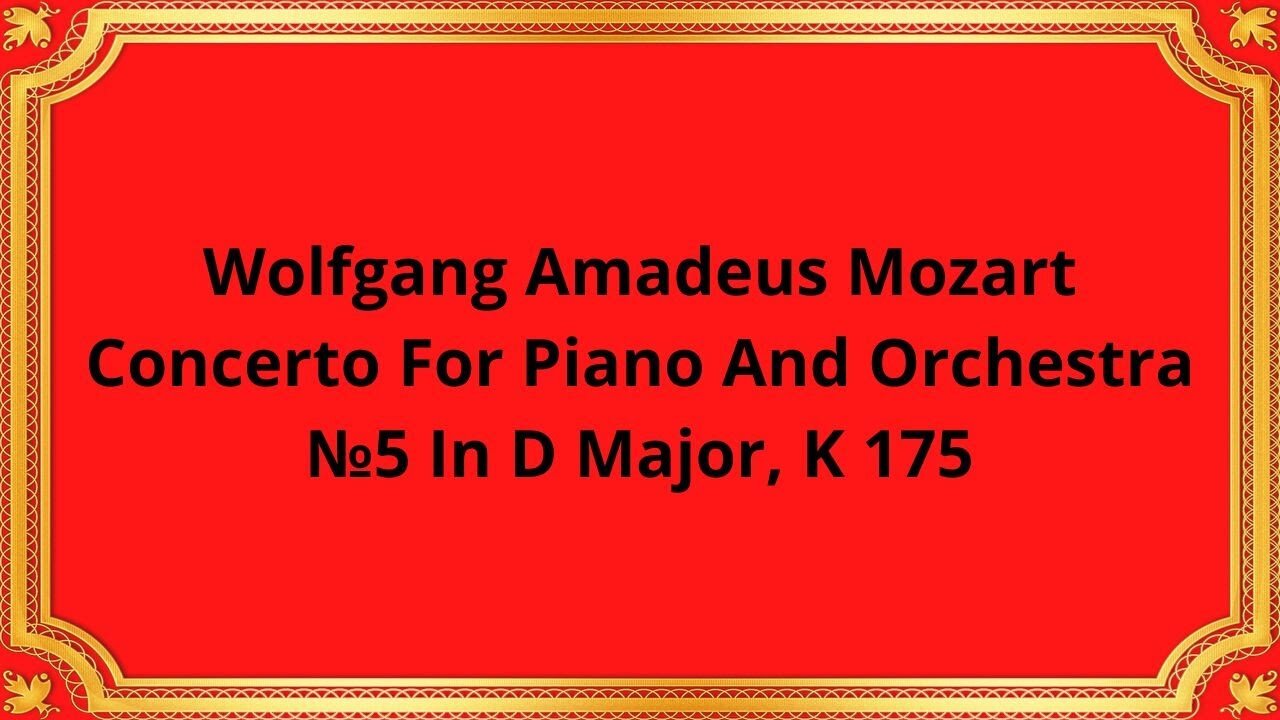Premium Only Content

Wolfgang Amadeus Mozart Concerto For Piano And Orchestra №5 In D Major, K 175
#Mozart #classicalmusic #pianoconcerto #musicalcomposition #Dmajor #K175 #WolfgangAmadeusMozart #orchestra
Publication date 1966
Salzburg Mozarteum Orchestra
Bernhard Paumgartner, Conductor
Wolfgang Amadeus Mozart, one of the greatest composers in musical history, left an indelible mark on the world of classical music with his remarkable compositions. Among his notable works, Concerto for Piano and Orchestra No. 5 in D Major, K 175, stands as a testament to his prodigious talent and innovative musical style.
Composed in 1773, during Mozart's early years, Concerto No. 5 in D Major, K 175, showcases his precocious talent as a composer and pianist. At the age of 17, Mozart was already making significant strides in the world of music, and this concerto demonstrates his mastery of the classical concerto form.
The concerto follows the traditional three-movement structure commonly found in classical concertos of the time. It begins with an Allegro movement, followed by a tender Andante, and concludes with a lively Allegro. Mozart's choice of D major as the key for this concerto adds a sense of brightness and exuberance to the overall composition.
The concerto is scored for solo piano and a small orchestra, typically consisting of strings, woodwinds, and horns. Mozart's orchestration allows for a delicate balance between the soloist and the accompanying ensemble, creating a harmonious and engaging musical dialogue.
Mozart's gift for crafting captivating and expressive piano melodies is evident throughout this concerto. The solo piano part not only showcases technical brilliance but also provides opportunities for the performer to convey a wide range of emotions, from lyrical and introspective passages to virtuosic flourishes.
Each movement of the concerto presents distinct musical characteristics. The opening Allegro is lively and energetic, featuring dazzling piano runs and spirited orchestral accompaniment. The Andante offers a contrasting mood, with its lyrical and tender melodies, while the final Allegro brings a sense of joy and exuberance through its spirited and playful themes.
Concerto No. 5 in D Major reflects Mozart's youthful exuberance and creativity. The composition displays a sense of exploration and experimentation, showcasing Mozart's ability to push the boundaries of musical conventions even at a young age.
While Concerto No. 5 in D Major may not be as widely recognized as some of Mozart's later works, it remains a testament to his prodigious talent and early contributions to the world of classical music. Its melodic beauty, technical brilliance, and youthful spirit have made it a beloved piece among pianists and classical music enthusiasts.
Conclusion:
Wolfgang Amadeus Mozart's Concerto for Piano and Orchestra No. 5 in D Major, K 175, stands as a testament to his exceptional talent and creative genius. Through its expressive piano writing, contrasting movements, and youthful spirit, this concerto captures the essence of Mozart's musical style during his early years. By exploring its historical context, structure, and notable characteristics, we gain a deeper appreciation for the brilliance and lasting impact of Mozart's musical legacy.
You have the opportunity to support the channel:
https://destream.net/live/RadSiarAl/donate
https://www.buymeacoffee.com/6355radsiaral
-
 1:29:26
1:29:26
Game On!
15 hours ago $3.21 earnedJon Jones vs Stipe Miocic Heavyweight Title Fight | UFC 309 Preview
9.05K1 -
 30:26
30:26
The Why Files
7 days agoThe Pascagoula UFO Incident | When Nightmares Come True
31K50 -
 1:40:28
1:40:28
Roseanne Barr
1 day ago $54.88 earnedUnredacting Jesus with Billy Phillips | The Roseanne Barr Podcast #74
123K152 -
 55:49
55:49
Stephen Gardner
19 hours ago🔥SECRET TRAPS laid for Trump, RFK & ELON | Megyn Kelly worries for Trump's life, CIA vote algorithm.
28.1K65 -
 1:24:47
1:24:47
Kim Iversen
18 hours agoMafia Tactics: A Private Equity Firm Forced Her Into An Abortion To Retaliate Against Her Speaking Up.
205K260 -
 2:36:29
2:36:29
Fresh and Fit
17 hours agoCall-In Show
192K43 -
 4:08:29
4:08:29
Nerdrotic
20 hours ago $102.26 earnedHollywood in PANIC! Woke Celebrity Meltdown, Penguin Finale CRUSHES! | Friday Night Tights #328
221K47 -
 1:41:22
1:41:22
The Officer Tatum
15 hours agoLIVE: Trump NOMINATES Karoline Leavitt, Whoopi "SMOLLETT" EXPOSED, & MORE | Officer Tatum Show EP 8
97.2K264 -
 30:25
30:25
Glenn Greenwald
17 hours agoGlenn Takes Your Questions Post-Election On The Trump Admin & More
191K118 -
 1:26:23
1:26:23
vivafrei
20 hours agoChinese and Indian INFILTRATION in Canadian Government? Live with David Krayden! Viva Frei Live
263K139